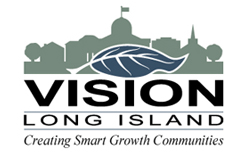*************DRAFT for discussion purposes only DRAFT**************
THE NASSAU BUSINESS AND COMMUNITY PLANNING COALITION MEETING:
Nassau Coliseum Redevelopment Proposals
BACKGROUND
On December 1 st , 2005 , the Nassau Council of Chambers of Commerce and Vision Long Island co-sponsored a meeting of the Nassau Business and Community Planning Coalition. The event centered on the proposals submitted by four prominent developers in response to Nassau County 's RFP [1] for the redevelopment of Nassau Coliseum. They are: The Coliseum Redevelopment Corp. (New York Mets/Sterling Equities/Blumenfeld Development), Lighthouse Development Group (Charles Wang/Reckson Associates), Polimeni International-The Cordish Co. and Engel Burman-Kabro Associates. In addition to representatives of each developer, over 90 people participated, including Chamber of Commerce leaders, Village Mayors, elected officials, and key members of the environmental, civic and educational institutions.
Broadly, the purpose of the gathering was to open up the previously closed-door negotiations between Nassau County Executive Tom Suozzi and Charles Wang, reinforcing the mandate that proper process be considered whenever the County is faced with any and all land-use decisions. Therefore, the multitude of Village and small-business leaders whom were not present at the Suozzi-Wang meetings were invited to view each group's proposal presentations first-hand, and were also afforded opportunity to ask questions and provide input.
The Coliseum parcel is especially important because although it is County land and is officially in Uniondale, the traffic, economic, and environmental impacts of the redevelopment will affect the neighboring Villages and Towns, including Hempstead, Mineola , Garden City and Westbury, as well as the entire county. In addition, the site is the home of the New York Islanders, the much-loved but often maligned hockey team owned by Wang, and operated by SMG, a venue management, marketing and development company. Thus, with so many different interests invested and proposed for the site, including the myriad of organizations invited in the proceedings was an essential step.
After introductions by NCCC President Richard Bivone and Eric Alexander, Executive Director of Vision Long Island, each developer presented their unique plans for the future of what many consider to be Nassau County 's most valuable land. The presentations ranged from straightforward Power Point presentations to professionally produced DVD productions. As the developers fine-tuned their AV equipment and representatives stated their respective cases, the general mood among the invited guests seemed to be guarded excitement. While the potential economic benefits for the County and surrounding towns are enormous, most Long Islanders have become shell-shocked when faced with development. In other words, because of the daily confrontation with so much bad development, people are increasingly resistant to any development.
PRESENTATIONS
Coliseum Redevelopment Corporation (Sterling Equities/Blumenfeld/NY Mets)
This conglomerate pairs the development knowledge of Blumenfeld with the sports-management experience of the NY Mets and Sterling Equities, the owners of the Mets and the Cyclones. Their plan features a 100,000 SF convention center, replacing the Coliseum's subterranean and sub-standard convention space, and a hotel, augmenting the current Long Island Marriot with 200 additional rooms. In addition, they propose to build a minor league baseball stadium along the lines of the Brooklyn Cyclone's Keyspan Park , noting that many cannot afford the high cost of attending a Mets game.
Like the Wang proposal, CRC's focus is on the expansion of sports operations on the Coliseum site, increasing the seating and retail capacity of the coliseum and providing additional parking spaces totaling 12,300 spots. Presenter David Blumenfeld stressed that their plan does not hinge on the Islanders, and that if they choose to leave their current home, there are many other options for the renovated Coliseum. There is lesser emphasis on housing, represented by two three-decked housing complexes that resemble the adjacent parking garage.
Moreover, in the County's RFP, they solicit the incorporation of the Hub MIS into each proposal. This is the only plan that adequately addresses the integration of mass transit into the site, the purpose of which is to reduce the amount of cars and congestion generated by the renewed Coliseum. Blumenfeld cited either a light rail between the LIRR's Hempstead Station, or a more aggressive monorail system from neighboring Mineola , a system Blumenfeld compared to the Jamaica Station-Howard Beach-JKF AirTrain.
What's Included: 1 million sq. ft. retail, 700,000 sq. ft. “lifestyle residential” with 20% housing designated “workforce” ($90,000 cap as defined in RFP), 500,000 sq. ft. office.
The Bottom Line: $1.4 billion, including $300 million for coliseum renovation and $100 million for 10,000 additional parking spaces.
Lighthouse Development Group LLC (Charles Wang/Reckson Associates)
The second presentation was made by Charles Wang himself, accompanied by Michael Picker of Lighthouse Development Group. Lighthouse began with a video of sweeping camera shots, detailing the aesthetic features, exciting retail prospects, and the “town square” concept embodied by a large green circled with shops and offices, and anchored by the 60-story “Lighthouse” of hotel and condo space. Large apartment towers with ground floor retail run parallel to a canal spanned by pedestrian bridges. The viewers were also offered a sports technology center, promised to become the “ Silicon Valley ” of the sports tech world, and a brand-new conference facility.
The Lighthouse itself was brushed over by the video and by Wang in the spoken portion of the presentation. Instead, he made broad statements emphasizing the importance of the establishment of industry on the island to keep and attract Long Island 's next generation, and that his sports technology center is the realization of such an industry. He also suggested partnerships with neighboring colleges to develop a sports technology curriculum or institute.
Wang reinforced his commitment to the Islanders, providing them a completely renovated Coliseum, replete with 80+ luxury boxes and state-of-the-art infrastructure. Special mention was given to his partner, Reckson Associates, which owns a number of properties ringing the site including EAB Plaza and the OMNI building, and Wang promised the shared-use of these buildings and their parking by the development's tenants.
While offering a laudable level of density, the Lighthouse plan did not assimilate a mass transit network, creating the specter of almost untenable car congestion for many audience members.
What's Included: 3.5 million sq. ft. residential, 1 million sq. ft. office, 500,000 sq. ft. office, 500,000 sq. ft. hotel/convention.
The Bottom Line: $1 billion, including $150 million to increase Coliseum to 17,500 hockey seats and 20,000 concert seats.
Polimeni International LLC – The Cordish Company
The third proposal marked a different approach to the Coliseum than the previous two, offering a new County seat. Vincent Polimeni outlined his consortium's plan, illustrating their proposal to consolidate the County's fragmented office system into a new 600,000 square-foot building complex. In exchange for the new buildings, Polimeni's group would receive the County's 77 acres of Coliseum land, subsequently putting it back on the tax rolls with Class A office space. Beyond the office space, Polimeni designed in three buildings for apartments or condos.
While a representative of the Cordish Company was not present, their role in the project should not be underestimated. They are the people responsible for the public-private redevelopment venture of Baltimore 's Inner-Harbor, a onceuggling downtown waterfront that is now a lucrative destination for Baltimoreans and tourists alike. They offer an impressive portfolio of public-private developments featuring high-profile entertainment and mixed-use districts.
What's Included: 650,000 sq. ft. residential, 1.2 million sq. ft. County Seat, 1.7 million sq. ft. office, 130,000 sq. ft. retail.
The Bottom Line: $725 million, including $150 million for coliseum renovations and an entertainment venue, and $75 million for a new county seat.
Engel Burman – Kabro Associates
The final presentation was by long-time Island builders Engel Burman. Headed by Jan Burman, their project proposes to drastically reduce the sports-related activities on the parcel, opting instead for a primarily residential and commercial use with a small retail base primarily for residents. Burman has two plans: either they develop the entire site with condominiums and office buildings, or the County (or Wang, for that matter) can retain the 37-acres of the Coliseum and EBK will populate the south-40 with condos.
Perhaps the least dense or retail-based of the three, it is understandable considering that Engel Burman's primary expertise is in residential developments. The residential component features four 15-story towers, two artificial lakes, and parking for 1,500 cars. Their portfolio includes The Bristol Assisted Living in Westbury and The Meadows, a condo complex in East Meadow .
What's Included: Plan A – 960,000 sq. ft. residential (four towers), 2 million sq. ft. office, 100,000 retail; Plan B – 960,000 sq. ft. residential.
The Bottom Line: $800 million, with promised rent returns of 2.5 – 5 million.
Visit http://www.co.nassau.ny.us/coliseum/index.html for a full listing of presentations and statistics.
QUESTIONS FOR CONSIDERATION
After the four developers concluded their presentations, the meeting launched into a productive and exciting Q&A session moderated by Mr. Bivone and Mr. Alexander. The audience's questions seemed to center on three main topics: transportation and traffic, housing (specifically affordable housing) and environmental impacts. While all the issues are absolutely essential to the current discussion surrounding the Coliseum, Bivone and Alexander made point that these plans are in their early stages of development, and each plan is still pending environmental and traffic studies.
Participants stressed an open mind when addressing land-use and transportation issues, as well as housing and environmental concerns.
Transit
- How does the project impact traffic? Can there be an integration of mass transit?
- Unless there is a massive paradigm shift (re: transit) might this not be built at all?
- Is the county willing to invest in mass transit?
- Should Mineola or Hempstead be the jump-off for transit?
Housing
- Do the proposals address Long Island 's affordable housing crunch?
- What are the bottom line percentages of affordable housing included in each developer's proposal?
- How does the Nassau HUB study fit into each proposal? Can we incorporate more transit? Maybe a monorail?
- What is the aquifer/environmental impact of this project?
Environment
- Is anyone planning on incorporating clean energy or green building?
- Can the current sewer infrastructure support such high density?
Miscellaneous
- Are the projects about Long Island or are they about developers?
• How does each project augment Nassau 's tax base?
• Who will construct the project? Union workers? Minimum wage workers?
• Can this become a cultural and entertainment destination?
• Can we draw people from beyond the island?
• Can these projects “do it all?” SHOULD they do it all?
[1] The County issued a Request for Proposals (RFP) for the site, with goals that included renovating the Coliseum as a "state of the art facility;" redevelopment consistent with the County's Master Plan for the area; keeping the Islanders, or attracting a comparable sports franchise; incorporating mass transit; and ensuring at least 15% of all housing develped at the site be "next generation" or "workforce" housing (affordable for a family earning $90,000/year or less).
The Long Island Neighborhood Network, http://longislandnn.org/hub/hubmis.htm ., accessed 12/2/05 .







